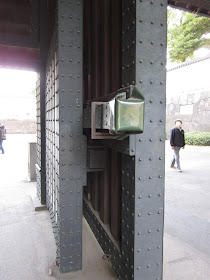Before the Ume season ended and the petals disappeared for another year, we decided to go to one more spot to see them. Ume are known as Plum Blossoms, but really they are a type of Japanese apricot. They are another of Japan's famous blossom seasons, besides the world famous and iconic cherry blossoms; I wrote about them during our visit to Koishikawa Kōrakuen. This time, we would be going straight into the Emperor's Palace itself in Tokyo to see the Ume. If you want to know more about the Emperor's Palace, I have written about the history of the Emperors and the Imperial Palace and gave a palace tour as well. With everything already explained for this time, we might as well get right to the action.
The Ume trees are located in the Eastern Garden of the Imperial Palace Grounds, which are open to the public. To get there, we have to go through the main gate, Ōtemon.
 |
| The entrance to the Eastern Gardens is right to the left of here after going through the gate. |
The garden is free to enter, but you need to pick up a card first that you return when you come back to leave. Right past the gate is the first taste of the Ume blossoms to be seen in the Eastern Gardens.
Since I haven't talked much about the Eastern Gardens yet, I'll give a short summary of what can be seen along the way besides the buildings I already talked about. In the first spot along the way is a traditional Japanese garden with a large pond.
In this pond are very fancy koi, with long ornamental fins.
Also along the way, the sakura or cherry blossoms are starting to bloom and take the spotlight from the Ume, but not yet.
 |
| A view of the pond from above it on the far side. |
Another Ume tree along the way, just before the Suwa no Chaya teahouse.
Here's a view of the teahouse coming from this path.
Right past the teahouse towards the north end of the park is the main Ume grove in the Imperial Palace. They look really impressive as they hug the old walls that made up the fortifications of this section of old Edo Castle.
| The first view of the Ume Grove along the path. |
This is the Bairinzaka (梅林坂), or Plum Tree Slope. The name might originate from Dokan Ota who was the original founder of Edo Castle, which would become the Imperial Palace of today. He planted many plum trees in this spot in 1478.
Heading up the slope, it eventually empties out right near the base of the main keep that still exists here, even though the castle has been gone for centuries. While the sakura trees in the traditional garden weren't bloomed yet, up on the hill there was one that had fully bloomed before the rest. Luckily, it was not near the Ume so they didn't have to compete, the Sakura tree definitely stole the show on the top of the hill near the castle base.
For comparison here are the closeups of the Ume blossoms:
This area at the top is the hill is the farthest we can go, so at this point we have to head back to the beginning. After handing back the card we head back out through Ōtemon again.
Here are some details of the Ōtemon gate:
 |
| The door and the inside beam to bar the door. |
 |
| The hinges to the massive door of this gate. |
Ume blossoms are the first of the year and the welcomer of spring. Traveling through the gardens to see them, we could start to see the nature around us awaken to spring, including this surprising sight at the corner of the wall near Ōtemon.
While it's sad to reach the end of the Ume season and not be able to see them again until next year, the season is also nice because it marks the beginning of spring in Japan and everything that awaits to be seen for the year.





























No comments:
Post a Comment